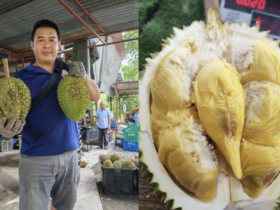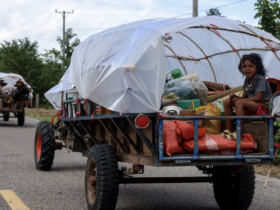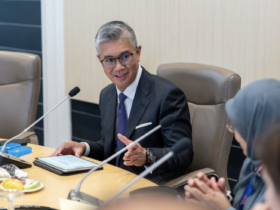BANGKOK, June 30 – Most people either love it or hate it, but durian — the spiky tropical fruit that “tastes like heaven, and smells like hell” — tops the list of Chinese consumers’ favorite food imports from Southeast Asia.
China’s love affair with the pungent smelling but sweet and creamy fruit is being met by farmers from Thailand, renowned worldwide as “the king of durian exporters”. And now, Chinese agricultural experts have stepped in to help their Thai counterparts upgrade and modernize the industry to meet the booming global demand and improve productivity.
The Thai Digital Economy Promotion Agency launched the Digital Durian Initiative late last year in a bid to modernize agriculture through smart technologies.
The program aims to help Thai durian farmers deal with uncertainties by using applications for recording, storing and tracking crop data.
“Thailand has perfect natural conditions for growing tropical fruits, and its durians are among the best in the region. With more than 200 species, Thai durians enjoy a global reputation,” said Zhou Zhaoxi, a researcher from the Chinese Academy of Tropical Agricultural Sciences.
Although China has been investing in durian cultivation in the country’s southeast coastal region, such as Hainan province, Zhou said that production is so limited it can barely meet the high domestic demand.
“For the long term, Thai durians will remain competitive in the Chinese market due to customers’ preference, along with their quality and production volume,” he added.
Sons of the soil
Thailand is the largest regional supplier of durian to China, its biggest international consumer market for the fruit.
Data from China Customs showed that the country imported approximately 1.56 million metric tons of durian with a total value of $6.99 billion last year, a new high. Of China’s total durian imports, nearly 60 percent were from Thailand.
As global demand for durians swelled in recent decades, many Thai farmers shifted from cultivating other fruits to growing durians for higher profits. However, the harvests are still vulnerable to factors such as the weather, plant diseases and soil quality problems.
“Local farmers are at the mercy of the forces of nature,” said farmer Chord Chanbuppha. “We water the orchards with an estimated amount, despite the fact that weather conditions in tropical areas are changing dramatically.”
The 56-year-old has been growing durian for years in Thailand’s Chanthaburi Province, the kingdom’s major production base for tropical fruits.
He said a lot of farmers in the province have shifted from planting longan and mangosteen to durian. But since it takes at least seven or eight years for a durian sapling to grow to maturity for harvesting, the input to output ratio is unpredictable.
Zhou, the researcher, noted that the industry in Thailand faces obstacles, including the lack of modern agricultural equipment.
In terms of dwarfing cultivation — a method that controls the plants’ height for easier management — its application in Thailand is still low, he said. “Taking integration of water and fertilizer as another example, the system has covered 70 to 80 percent of medium and big-size farms in China, but is barely seen in Thai orchards,” he said.
Chord is among the farmers in Chanthaburi who have benefited from Chinese agricultural technologies.
With support from the Chinese Ministry of Agriculture and Rural Affairs, the orchard he works at was upgraded last year with the help of Beyondsoft Corp, a Chinese company specializing in information technology products, solutions, and services.
Pilot project
About an hour’s drive north of downtown Chanthaburi city, a durian orchard covering an area of eight hectares emerges from the lush woods. Home to 640 young durian trees, it is a Beyondsoft pilot project.
In the orchard, integration of water and fertilizer has been introduced, which reduces water consumption while doubling the efficiency of fertilization and pest control. A soil detection system has also been installed to collect data on mineral elements, soil moisture, and pH value.
Chang Canxian, managing director of Beyondsoft’s Southeast Asia Region Operations, said the orchard has a real-time monitoring system for weather forecasting. It records durian trees’ growing conditions while monitoring pests and diseases.
“All those data will be uploaded to an online system, providing guidance for scientific farming. Together, the smart solutions will significantly reduce human labor costs and largely improve farming efficiency,” Chang said.
“Moreover, we have an expert team that can provide support either online or on-site as requested, covering farming suggestions and technical assistance.”
According to Zhao Gang, who is in charge of Beyondsoft’s Digital Tech and Software Department, the company has so far helped upgrade three tropical fruit farms in Thailand using smart technologies. Apart from Thailand, it has also worked in countries such as Malaysia, Vietnam, and Cambodia, to upgrade local farms into smart ones.
“Together with the internet of things, smart orchard application systems, big data platforms and traceability application systems, we aim to provide a comprehensive digital solution, empowering production, management, and sales at multiple levels while enhancing agriculture efficiency, as well as economic benefits to local farmers,” he said.
According to statistics from the Chanthaburi Chamber of Commerce, the province will export an estimated 800,000 metric tons of durians this year, and the amount is expected to surge to 1.1 million next year. Nearly 90 percent of the export volume will go to the Chinese market.
Global appeal
Thanachot Nontakatrakool, an economics researcher at Bangkok Bank, said once confined to Southeast Asian palates, durian is now crossing borders and mindsets. “In the United States, United Kingdom, and Australia, it is showing up in fusion desserts, high-end grocers, and even as limited-edition flavors in global food chains,” he said.
As Thai exporters are keen to maintain their reputation for quality durian in the international market, major exporters are also seeking to improve the whole production chain via innovation, aimed at meeting international standards.
Since 2023, Thailand agri-food company CP Group has collaborated with the Agricultural Research Development Agency and Chinese tech giant Huawei Cloud to develop quality inspection systems combining infrared sensors and cloud-based artificial intelligence.
“Harvested durians should go through inspection,” said Ronnarit Rittiron, head of the Laboratory Department of Food Engineering Faculty at Kasetsart University in Bangkok. “The traditional method is for a skilled evaluator to lightly tap on the fruit with a special stick, with the sound indicating whether it is ripe and of suitable quality.
“Errors can and do occur, especially as many inspectors are new to the job,” said Ronnarit, who is a member of the team that developed the smart solution based on Huawei’s AI technology.
The solution involves gun-shaped sensors that emit near-infrared radiation when pointed at the fruit’s skin. The collected data is uploaded to the cloud, where artificial intelligence determines whether the fruit is ready to be cut and sold. The process does not ruin the flesh inside.
“We now manage to achieve 80 percent accuracy. And the accuracy will rise as more data is collected,” said Jiang Yuejun, chief technology officer at CP Group.
“For the smart agriculture industry, we expect AI to play a major role with the internet of things, robotics, drones and satellites,” he said.
“Joining hands with Chinese tech giants such as Huawei, we provide a digital transformation of the agricultural industry, which will help more farmers and the industry as a whole,” he added.


-加码-scaled.jpg)

-加码-scaled.jpg)


















Leave a Reply